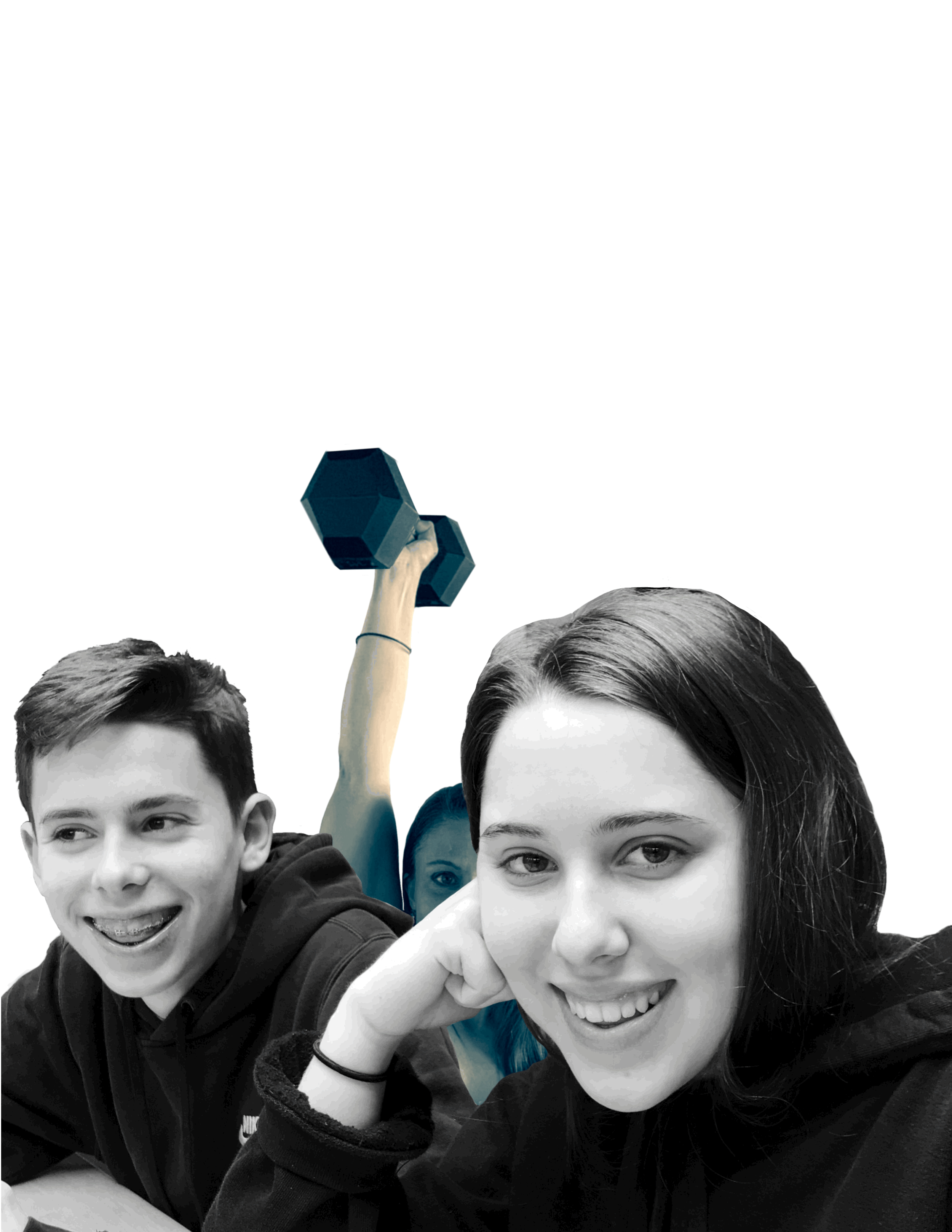Mission Impossible? Training Together - Teens and Fitness: Part 2
Your mission should you choose to accept it….
Before I had kids of my own, I had a limited view of teens and fitness. Either I experienced teenagers taking part in school athletics, watched Mark Van Dyke jogging around my hot Texas cul-de-sac in a sweatsuit trying to burn calories, or saw my brother go to the gym every day over summer break transforming himself into an Abercrombie and Fitch lookalike model. Seeing teens workout in organized sports or alone was my only framework. Never did I envision a parent, much less a mother, going to the gym with her teenager to lift weights.
Lucky for me, times have changed, and while it still isn’t the norm to see parents working out in a gym with their teens, it certainly isn’t considered weird. Five years ago I decided that I would accept the “mission” to explore fitness with my teenagers, and while the journey has not been without challenges, it has been one of my proudest moments as a parent. In order to be successful in this endeavor, you don’t need to be a personal trainer, but you must have a willingness to ride out the bumpiness of the journey with the overall goal in mind. And that goal is a desire to help create lifelong healthy mindsets and habits around movement.
According to Mark Tremblay, it’s no surprise that, “Global trends, including excessive screen time, are contributing to a generation of inactive children and putting them on a dangerous path. We have a collective responsibility to change this because inactive children are at risk for adverse physical, mental, social and cognitive health problems.” And from first hand experience, I have seen how the rise of social media and video games (heck, the invention of the computer) coupled with less purposeful physical activity at school can lead the average teenager to be prone to moving less. And while this inactivity certainly affects the body, it has a huge impact on their mental health as well. According to the Mayo Clinic, “The links between depression, anxiety and exercise aren’t entirely clear-but working out and other forms of physical activity can definitely ease symptoms of depression or anxiety and make you feel better.”
Knowing all of the positives that exercise brings, the real challenge is figuring out how to come alongside our teenager in a way that is positive and meaningful for all involved and that doesn’t elicit feelings of frustration resulting in a kettlebell being thrown into the gym mirror (don’t worry, I have never done this).
So, where does one jump in, or “box jump” in?
Approach exercise like anything else that you would like your child to do for their betterment.
Purposeful movement should not be something that we show our kids you only do when you feel like it. I have always found it normal to tell both of my children that I expected them to make their bed, clean their room, read books on their own, practice piano, help clear the table, etc. Of course there have been times that they have rebelled and whined (piano in particular was always a wrestling match), but for the most part they have come to realize that there are some things that are required of them for their own good, and that we do so because of our family values. Exercise, in my mind, is no different and can become a habit, similar to making the bed. So it didn’t seem bizarre years ago when I came to my daughter saying, “Hey, remember how last summer I signed you up for camp to learn how to use Photoshop and then I also helped you to have summer book reading goals? This summer, I would love to see you learn how to lift weights. We have worked on your reading goals for years; let’s now work on your movement.”
Normalize the fact that it might not initially sound appealing to your teen to start working out with you.
I wasn’t shocked when my daughter didn’t jump at the idea to accompany me to the gym. She had not tried it, and it looked intimidating when she imagined grunting, sweaty adults distorting their bodies on metal machines resembling something that could be found on a sci-fi spaceship. Assuring her, “I understand that working out doesn’t look like it will be fun because you have never done it and that is how I felt before I started going to the gym regularly. But I really enjoy spending time with you and I know we will have such a good time hanging out. And if you have a willing attitude, I bet you will learn to like learning new things. Plus, you will get really strong. Let’s just give it some time and see.”
Don’t be afraid to incentivize their early experiences.
If you have never rewarded your child with experiences or money upon completion of certain tasks, and they simply do things out of the goodness of their hearts, well, I applaud them and you. But that has not been my experience. Just like I didn’t have a problem rewarding my kids when they read books for the summer or completed a huge household project, so have I given allowance for going to the gym in the beginning months just like I would when they cleaned their room or did the dishes. Of course, once my child saw the benefit for herself, monetary incentives were no longer necessary.
Set the bar (not the weight bar) low.
Unless your teen embraces strength training from the onset like my brother, don’t push them to go to the gym with you multiple times a week for hours on end. Lifting weights once (maybe twice) a week in the beginning months for 30 minutes each time is a very good goal. Just like with my clients, I would rather see a person consistently strength training 1-2 times a week, than a person who goes four days in a row once a month. My mantra early on was, “Anything is better than nothing.” And with a solid foundation of consistent habits you will most likely find your teen going with you more often and owning their own fitness in the months and years ahead.
Encourage your teen every chance you get.
Even more important than the weights we have lifted is the affirmation that we give. Encouraging statements such as, “I absolutely loved going to the gym with you today, you were so much fun to workout with, I am so impressed by your good form, thank you for having such a teachable spirit, it felt so good to work hard together, you are so strong,” work wonders. Find every moment of goodness and mention it. Not only is this uplifting to your child, but it leaves them feeling positive about how exercise affects their body and mind. Your words cannot help but spillover into how they view movement and themselves in general. Five years on, neither of my children have ever come back from the gym saying that they feel worse about life than when we went. And through this I am subtly teaching them, “Everything is better with movement.”
Plan together.
Rarely do I ever wait until the last minute to ask my kids to go to the gym with me as I haven’t found any success in this method. Usually I will look at the week’s schedule (especially during the school year), come to my teen and let them know that I would like to workout together once (or twice) that week, and ask when that would be possible. This gives us a chance to plan our schedule in advance and to work around any other commitments that could get in the way. Furthermore it shows your teen how to practically make time for things that are important as even adults have to plan when to get in purposeful movement, as it rarely just magically happens.
Of course there will be times when plans change last minute, but having a date becomes a way that you and your teen are accountable to one another. The life lessons of learning to honor your word even when you don’t feel like it are priceless.
Enjoy this time together.
Not only do you have the privilege of teaching your child something that has the potential to positively affect their life forever, but you can also have a wonderful time bonding together. So many conversations have occurred on the weight room floor that I wouldn’t trade for anything. And maybe I am just blessed to have grateful children, but they regularly affirm me for giving my time for their betterment. Working out together may not always be easy, but it is so worth it. It is certainly “mission possible.”
In my final article on teens and fitness I will address how to plan a strength training workout with exercise suggestions. I will also navigate how to address teaching proper form without sounding like a drill sergeant, when (and if) to do cardio, and how to feel like you can still get a good workout for yourself during this journey.
Stay tuned.
Mayo Clinic staff. “Depression and Anxiety: Exercise Eases Symptoms.” mayoclinic.org. n.p., 27 September 2017. Web. n.d.
Archer, Shirley. “Kids’ Inactivity: A Global Crisis.” Idea Fitness Journal. Cruz Bay Publishing, April 2019. Print

